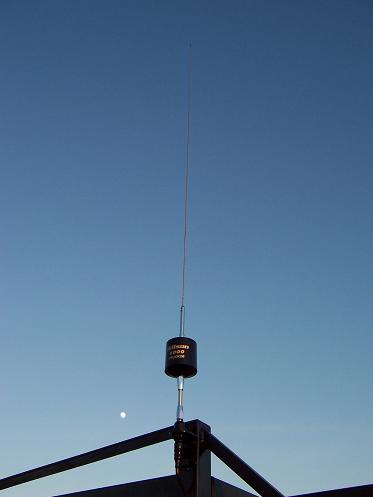    
Tech833
Moderator
Username: Tech833
Post Number: 1809
Registered: 8-2002
| | Posted on Friday, January 29, 2010 - 3:52 pm: | 


|

Wilson 5000 Trucker antenna review
‘Trucker’ style antennas are those having a 3/8 inch, 24 thread stud and typically fall into one of two categories- Helical fiberglass, like the Firestik, and base or center loaded metal. Fiberglass antennas offer flexibility and vibration resistance, as well as being inexpensive. They lack power handling capability and bandwidth (for those who want to travel outside the CB band).
Many of the steel type antennas intended to be used on trucks are designed with strength and durability in mind, as well as some kind of power handling capability. Enter the Wilson 5000 Trucker antenna.
The Wilson 5000 Trucker should be called a base loaded antenna since the loading coil is very close to the mounting stud base, although, not right at the base. Perhaps this is best described as base-center loaded.
High quality materials are used for the Wilson 5000 Trucker antenna construction with stainless steel lower shaft and flexible whip. The tapered, stainless steel whip is held in place by two setscrews, which provides a very secure grasp on it. 3/8 inch threads on the lower shaft are integral to the shaft material itself.
The Wilson 5000 Trucker coil is fully enclosed in a UV stabilized plastic compound radome, which also carries the brand in gold screened lettering on it. Inside the radome is several turns of silver plated copper wire forming the coil. From the cutaway views, it appears to be around 9 turns in the coil. I did not cut open the coil form to inspect as this antenna was needed for another project.
I experimented with the Wilson 5000 Trucker on a few different vehicles to measure the bandwidth and even experiment with power handling capability. I had no trouble at all tuning the Wilson 5000 Trucker for the 10m amateur band so I could legally use up to 1500 watts of power for some real-life on air testing.
In all of the installations, a low SWR was quick and easy to obtain. The Wilson 5000 Trucker does not seem picky about coax cable length like some other ‘trucker’ style ungrounded type antennas. 1:1 SWR in the center of the CB band would give a 1.2:1 to 1.3:1 SWR on the outer edges in every installation I tried. The Wilson 5000 Trucker has a fairly high Q coil, which does limit the overall bandwidth of the antenna compared to some of the large-coil types and the 9 foot whip. However, for a 5-foot tall or less antenna, the Wilson 5000 Trucker’s bandwidth is very acceptable. It still has much better bandwidth than a typical fiberglass helical wound antenna. The less than 2:1 SWR curve in one sweep was just over 2 MHz. wide.
When at highway speeds, the Wilson 5000 Trucker bends very little, with the top bending only about 15 degrees from vertical at 65 MPH. Yet, the Wilson 5000 Trucker is still plenty flexible to resist breaking if struck by a low tree limb. The lower shaft is not flexible at all, so keep this in mind if that afore mentioned tree limb is at or below coil height. You WILL break something in that case. Probably your mount!
On-air testing showed greatly improved performances in both transmit and receive over a Firestick. The performance boost became much more evident when tuning into the 10m amateur band. The Wilson 5000 Trucker did not require retuning for receive into 10m, but the Firestik gets really deaf outside the CB band and was almost useless on 10m, even for receiving only. In band, signals were typically 1 s-unit better on transmit and 2 s-units better on receive. On the range, gain was measured at -3.1 dB compared to ˝ wave dipole antenna. This is good considering the Firestik I tested measures -5.1 dB (that’s negative 5.1 dB)!
For those with super-power, you might want to look elsewhere, but for those using 1000 watts or less, the Wilson 5000 Trucker will handle what you can dish out. Running 1,000 watts in CW mode (carrier power), the Wilson 5000 Trucker shows little signs of heat buildup. That’s good, as heat is a sign of RF resistance which would lead to antenna failure.
If you want to add a 4” heavy duty spring to the Wilson 5000 Trucker, you need to shorten the whip by only about 3/4 inch, in my tests. There is plenty of travel in the whip mounting stud, so you can make this adjustment easily, and repeatedly.
The fit and finish of the Wilson 5000 antenna is certainly in the top of all the antennas I have tested. Great attention to detail is given as all seams are flawless and the antenna comes ready to use without having to re-engineer the thing.
High quality and fairly good performance in a 5-foot tall antenna; that is the Wilson 5000 Trucker.
-Tech 833
Your radio 'Mythbuster' since 1998
|



